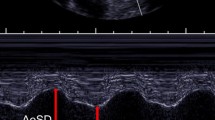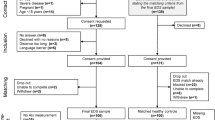Abstract
Our aim in this study is to evaluate the cardiovascular findings of pediatric patients with primary Raynaud’s phenomenon (RP) and to determine if there are any pathological findings. Our study included 42 pediatric patients aged between 7 and 18 who were diagnosed with primary RP and did not have any additional underlying structural vascular disease or secondary rheumatological conditions. The control group consisted of 30 healthy volunteers aged 7–18 years, matched by age and sex, without any additional diseases. We evaluated demographic, clinical, and laboratory findings, echocardiographic and capillaroscopic features, as well as carotid intima-media thickness. Compared to the control group, pediatric patients with primary RP showed increased A wave velocity and E/E' ratio parameters in the left ventricle, indicating diastolic dysfunction of the heart. The isovolumetric relaxation time (IVRT) was prolonged in both the left and right ventricles, and the E/A ratio decreased in the left ventricle. The myocardial performance index (MPI), indicating both systolic and diastolic dysfunction, increased in both ventricles. Additionally, the aortic stiffness index, aortic elastic modulus (Ep), and left carotid intima-media thickness (CIMT) significantly increased, while distensibility decreased in pediatric patients with primary RP compared to the control group. The cardiovascular evaluation of pediatric patients with primary RP revealed that diastolic dysfunction is likely present in both the left and right heart. Additionally, based on the aorta and carotid intima measurements, it is suggested that pediatric patients with primary RP are at risk for developing atherosclerosis.
Similar content being viewed by others
Data Availability
No datasets were generated or analysed during the current study.
References
Wigley FM, Flavahan NA (2016) Raynaud’s phenomenon. N Engl J Med 375:556–565. https://doi.org/10.1056/NEJMra1507638
Jones GT, Herrick AL, Woodham SE, Baildam EM, Macfarlane GJ, Silman AJ (2003) Occurrence of Raynaud’s phenomenon in children ages 12–15 years: prevalence and association with other common symptoms. Arthritis Rheum 48:3518–3521. https://doi.org/10.1002/art.11340
Cakır N, Pamuk ÖN, Derviş E, Imeryüz N, Uslu H, Benian Ö, Elelçi E, Erdem G, Sarvan FO, Senocak M (2012) The prevalences of some rheumatic diseases in western Turkey: Havsa study. Rheumatol Int 32:895–908. https://doi.org/10.1007/s00296-010-1699-4
Fuhlbrigge R (2016) Raynaud phenomenon and vasomotor syndromes. In: Petty RE, Laxer RM, Lindsley CB, Wedderburn LR (eds) Textbook of pediatric rheumatology, 7th edn. Elsevier, Amsterdam, pp 436–447
Cutolo M, Sulli A, Pizzorni C, Accardo S (2020) Nailfold videocapillaroscopy assessment of microvascular damage in systemic sclerosis. J Rheumatol 27:155–160
Stein JH, Korcarz CE, Hurst RT et al (2008) Use of carotid ultrasound to identify subclinical vascular disease and evaluate cardiovascular disease risk: a consensus statement from the American Society of Echocardiography Carotid Intima-Media Thickness Task Force. Endorsed by the Society for Vascular Medicine. J Am Soc Echocardiogr 21:93–111. https://doi.org/10.1016/j.echo.2007.11.011
Lang RM, Badano LP, Mor-Avi V et al (2015) Recommendations for cardiac chamber quantification by echocardiography in adults: an update from the American Society of Echocardiography and the European Association of, Cardiovascular Imaging. Eur Heart J Cardiovasc Imaging 16:233–270. https://doi.org/10.1093/ehjci/jev014
Quiñones MA, Otto CM, Stoddard M et al (2002) Recommendations for quantification of Doppler echocardiography: a report from the Doppler Quantification Task Force of the Nomenclature and Standards Committee of the American Society of Echocardiography. J Am Soc Echocardiogr 15:167–184. https://doi.org/10.1067/mje.2002.120202
Nigrovic PA, Fuhlbrigge RC, Sundel RP (2003) Raynaud’s phenomenon in children: a retrospective review of 123 patients. Pediatrics 111:715–721. https://doi.org/10.1542/peds.111.4.715
Pope J (2013) Raynaud’s phenomenon (primary). BMJ Clin Evid 2013:1119
Maricq HR, Carpentier PH, Weinrich MC, Keil JE, Palesch Y, Biro C, Vionnet-Fuasset M, Jiguet M, Valter I (1997) Geographic variation in the prevalence of Raynaud’s phenomenon: a 5 region comparison. J Rheumatol 24:879–889
Falcini F, Rigante D, Candelli M, Martini G, Corona F, Petaccia A, La Torre F, Raffaele CG, MatucciCerinic M (2015) Anti-nuclear antibodies as predictor of outcome in a multi-center cohort of Italian children and adolescents with Raynaud’s phenomenon. Clin Rheumatol 34:167–169. https://doi.org/10.1007/s10067-014-2833-6
Pavlov-Dolijanović S, Damjanov N, Ostojić P, Susić G, Stojanović R, Gacić D, Grdinić A (2006) The prognostic value of nailfold capillary changes for the development of connective tissue disease in children and adolescents with primary Raynaud phenomenon: a follow-up study of 250 patients. Pediatr Dermatol 23:437–442. https://doi.org/10.1111/j.1525-1470.2006.00278.x
Borowiec A, Dabrowski R, Wozniak J, Jasek S, Chwyczko T, Kowalik I, Musiej-Nowakowska E, Szwed H (2012) Cardiovascular assessment of asymptomatic patients with juvenile-onset localized and systemic scleroderma: 10 years prospective observation. Scand J Rheumatol 41:33–38. https://doi.org/10.3109/03009742.2011.609489
Dedeoglu R, Şahin S, Koka A, Öztunç F, Adroviç A, Barut K, Cengiz D, Kasapçopur Ö (2016) Evaluation of cardiac functions in juvenile systemic lupus erythematosus with two-dimensional speckle tracking echocardiography. Clin Rheumatol 35:1967–1975. https://doi.org/10.1007/s10067-016-3289-7
Jourdan C, Wühl E, Litwin M, Fahr K, Trelewicz J, Jobs K, Schenk JP, Grenda R, Mehls O, Tröger J, Schaefer F (2005) Normative values for intima-media thickness and distensibility of large arteries in healthy adolescents. J Hypertens 23:1707–1715. https://doi.org/10.1097/01.hjh.0000178834.26353.d5
Acknowledgements
None.
Funding
No specific funding was received from any bodies in the public, commercial, or not-for-profit sectors to carry out the work described in this article.
Author information
Authors and Affiliations
Contributions
Ş.Ö., H.B. and H.E.S wrote the main manuscript text, and S.D., S.S., and H. H collected the data. All authors reviewed and approved the manuscript.
Corresponding author
Ethics declarations
Conflict of interest
The authors declare no conflict of interest.
Additional information
Publisher's Note
Springer Nature remains neutral with regard to jurisdictional claims in published maps and institutional affiliations.
Rights and permissions
Springer Nature or its licensor (e.g. a society or other partner) holds exclusive rights to this article under a publishing agreement with the author(s) or other rightsholder(s); author self-archiving of the accepted manuscript version of this article is solely governed by the terms of such publishing agreement and applicable law.
About this article
Cite this article
Özpınar, Ş., Bornaun, H., Sönmez, H.E. et al. Pediatric Primary Raynaud's Phenomenon: A Comprehensive Cardiovascular Analysis. Pediatr Cardiol (2024). https://doi.org/10.1007/s00246-024-03514-9
Received:
Accepted:
Published:
DOI: https://doi.org/10.1007/s00246-024-03514-9




